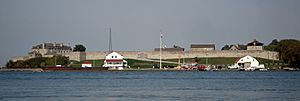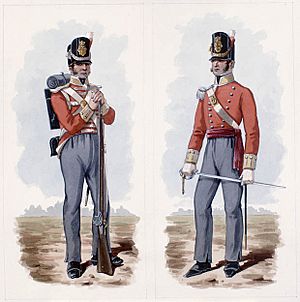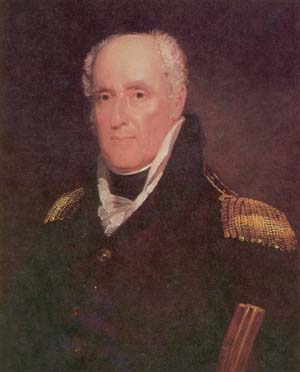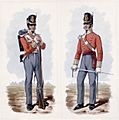Capture of Fort Niagara facts for kids
Quick facts for kids Capture of Fort Niagara |
|||||||
|---|---|---|---|---|---|---|---|
| Part of War of 1812 | |||||||
 View of Fort Niagara from the Ontario side of the Niagara River |
|||||||
|
|||||||
| Belligerents | |||||||
| Commanders and leaders | |||||||
| Gordon Drummond, John Murray |
Nathaniel Leonard | ||||||
| Strength | |||||||
| 500 British regulars 50 Canadian militia 12 First Nations militia |
324 regulars unknown number militia |
||||||
| Casualties and losses | |||||||
| 6 killed 5 wounded |
65-80 killed 14 wounded prisoners 344 captured |
||||||
The Capture of Fort Niagara happened in late 1813. It was during the War of 1812 between the United Kingdom and the United States. The American soldiers defending the fort were surprised. British soldiers captured the fort in a night attack.
Contents
Why Fort Niagara Was Important

Fort Niagara was a very important American fort. It was located near where the Niagara River meets Lake Ontario. Early in the war, the fort often exchanged cannon fire. This was with the British Fort George across the river.
In May 1813, the Americans won the Battle of Fort George. This victory gave them control of Fort George. They also briefly took over the entire Niagara area. But soon, they were pushed back to a small area around Fort George.
Later that year, most American regular soldiers left the Niagara area. They were sent to Sacket's Harbor. This was to prepare for an attack on Montreal. These soldiers were replaced for a short time. But then, these new soldiers also left. This left only a small group of soldiers to defend Fort George. Brigadier General George McClure was in charge. He had only 60 regular soldiers and some volunteers.
The Burning of Niagara
In late 1813, Major General Francis de Rottenburg was a British leader. He was worried about recent defeats. He ordered British troops in the Niagara area to retreat. He planned to move them even further back.
However, in December, Lieutenant General Gordon Drummond took over. Drummond was a stronger leader. He knew the American attack on Montreal had failed. He immediately stopped the retreat. Instead, he ordered his troops to advance.
On December 10, General McClure learned of this advance. He felt his position was too weak. He quickly moved his troops to Fort Niagara. The cannons at Fort George could not be moved. So, they were thrown into the fort's ditch.
Earlier in the year, the U.S. Secretary of War, John Armstrong, had given permission. He said the nearby village of Niagara could be destroyed. This was if it helped stop British troops from hiding there. The people were supposed to get notice. They were also supposed to be helped.
But as Americans left Fort George, McClure ordered the village burned. He gave only two hours' warning. This left the people without homes in winter. Part of Queenston was also burned. Some said American-allied Canadian volunteers did most of the burning.
This action went against the rules of war at the time. However, both sides had done similar things before. The burning of Niagara became the reason for later British attacks.
The Attack on Fort Niagara

After the British took back Fort George, Fort Niagara was in danger. Captain Nathaniel Leonard was in command of Fort Niagara. He had not been performing his duties well. Orders to replace him had not been carried out. The fort's defenses were also in poor condition. Damage from earlier fighting had not been fixed.

General Drummond ordered boats to be brought forward. On the night of December 18, a British force crossed the river. They were about 3 miles (5 km) above Fort Niagara. This force had 562 soldiers. Colonel John Murray was in command. They carried axes and ladders. They were ordered to use bayonets to keep the attack a surprise.
The British captured American guards in Youngstown. These guards were trying to stay warm instead of watching. One prisoner was forced to tell the British the American password. The British then moved silently towards the fort.
A small group of British soldiers approached the gate. A sergeant pretended to have an American accent. He confused the guard long enough to get inside. By the time the Americans realized what was happening, it was too late. The British rushed into the fort.
Most of the fighting happened in two buildings. These were the South Redoubt and the Red Barracks. Some American defenders barricaded themselves inside the South Redoubt. They fought off many attempts to break in. But when they refused to surrender, the British commander gave a harsh order. When the attackers forced their way in, the defenders were killed.
Results of the Battle
Only six British attackers were killed. Five were wounded.
The British reported that 65 Americans were killed. They also captured 14 wounded and 344 other prisoners. However, an American civilian named Robert Lee said more Americans were killed. He believed at least 80 Americans died. He said many were found killed in the cellars of buildings. Captain Leonard was captured at his home nearby.
What Happened Next
Another British force followed Murray's troops across the river. They captured several American outposts. They then burned almost every village on the American side of the river. This included Lewiston and a nearby Native American settlement. This was in revenge for the burning of Newark (Niagara). Some Native American allies were with the British.
After returning to the Canadian side, the British moved upstream. On December 30, they crossed the Niagara River again. They defeated American forces at the Battle of Buffalo. After this, the villages of Black Rock and Buffalo were burned. The navy yard was also destroyed.
Fort Niagara stayed under British control until the end of the war.
Images for kids
-
Fort Niagara (right) in 1793. The Fort was an important American outpost near the outlet of the Niagara River into Lake Ontario.
-
A soldier and officer of the 100th Regiment of the Foot, around 1814. On December 18, this regiment and others crossed the Niagara River.





